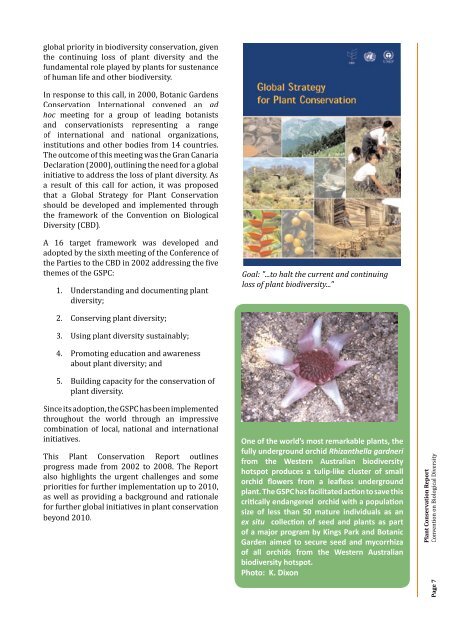Convention on Biological DiversityPlant Conservation Report Page 6INTRODUCTIONTHE ESSENTIAL ROLE OF PLANT DIVERSITYPlants are universally recognized as a vitalcomponent of biodiversity and <strong>global</strong>sustainability. For example, <strong>plant</strong>s providefood (around 7,000 1 species are used <strong>for</strong> food 2 ),ibre, fuel, shelter, medicine. Healthy ecosystemsbased on <strong>plant</strong> diversity provide <strong>the</strong> conditionsand processes that sustain life and are essential to<strong>the</strong> well-being and livelihoods of all humankind.Ecosystem services provided by <strong>plant</strong>s include:• The production of oxygen and assimilation/sequestration of carbon dioxide (CO 2)in both terrestrial and marine systemsthat currently removes about 50% ofanthropogenic CO 2emission;• The creation, stabilization and protectionof soil, essential <strong>for</strong> most of <strong>the</strong> Earth'sproductive agricultural systems and<strong>the</strong> major carbon pool in <strong>the</strong> terrestrialbiosphere; and• The creation and protection of watersheds,slowing run-off rate of precipitationand promoting water iniltration andpuriication.Plants also <strong>for</strong>m <strong>the</strong> basis of <strong>the</strong> trophic pyramidin all terrestrial and most marine ecosystems onwhich we and all o<strong>the</strong>r animal species inevitablydepend. In addition, <strong>plant</strong>s provide a vast multitudeof natural resources <strong>for</strong> humanity, especially in<strong>the</strong> developing world. They provide <strong>the</strong> basis <strong>for</strong>all of our food, most medicines and many o<strong>the</strong>rmaterials essential <strong>for</strong> our daily lives.nature during <strong>the</strong> course of <strong>the</strong> 21 st century (GranCanaria Declaration - 2000) 3 .Extinction and declines in <strong>plant</strong> diversity isdue to a range of factors including populationgrowth, high rates of habitat modiication andde<strong>for</strong>estation, over-exploitation, <strong>the</strong> spread ofinvasive alien species, pollution and climatechange. The Millennium Ecosystem Assessmentnoted that approximately 60% of <strong>the</strong> ecosystemservices evaluated are being degraded or usedunsustainably. 4 The degradation of ecosystemservices often causes signiicant harm to humanwell-being and represents a loss of a natural assetor wealth of a country. The assessment also noteda continual decline in <strong>the</strong> status of provisioningservices of <strong>the</strong> environment, especially wild foods,timber, cotton, wood-fuel, genetic resources, andmedicine. It is clear that <strong>the</strong> overall trend <strong>for</strong> <strong>plant</strong>diversity is declining.The Global Strategy <strong>for</strong> Plant Conservation(GSPC)The 16 th International Botanical Congress inSt. Louis, Missouri in 1999 called <strong>for</strong> <strong>plant</strong><strong>conservation</strong> to be recognized as an outstandingThe overall status and trends of <strong>plant</strong>diversityAn accurate picture of <strong>the</strong> status of <strong>plant</strong>s and <strong>the</strong>trends that are impacting on <strong>the</strong>m is dificult todetermine. Indeed, we do not yet know <strong>the</strong> exactnumber of <strong>plant</strong> species in <strong>the</strong> world (estimatedcurrently at 370,000 known species). However,it is predicted that as many as two-thirds of <strong>the</strong>world’s <strong>plant</strong> species are in danger of extinction in1 Wilson, E.O. (1992). The Diversity of Life. Penguin,London, UK. 432 pp2 http://www.underutilized-species.org/documents/PUBLICATIONS/gfu_icuc_strategic_framework.pdf3 Blackmore, S.; Bramwell, D.; Crane, P.;Dias, B;Given,F.,T.,Leiva, A; Morin, N.R.; Pushpangadan,P.; Raven,P.H.; Samper, C.; Sarukhan, J.,J.; Simiyu, S.;Smirnov,I;and Wyse Jackson, P.S. (2000). The Gran CanariaDeclaration, BGCI, Richmond, U.K.4 www.milleniumassessment.org
<strong>global</strong> priority in biodiversity <strong>conservation</strong>, given<strong>the</strong> continuing loss of <strong>plant</strong> diversity and <strong>the</strong>fundamental role played by <strong>plant</strong>s <strong>for</strong> sustenanceof human life and o<strong>the</strong>r biodiversity.In response to this call, in 2000, Botanic GardensConservation International convened an adhocmeeting <strong>for</strong> a group of leading botanistsand <strong>conservation</strong>ists representing a rangeof international and national organizations,institutions and o<strong>the</strong>r bodies <strong>from</strong> 14 countries.The outcome of this meeting was <strong>the</strong> Gran CanariaDeclaration (2000), outlining <strong>the</strong> need <strong>for</strong> a <strong>global</strong>initiative to address <strong>the</strong> loss of <strong>plant</strong> diversity. Asa result of this call <strong>for</strong> action, it was proposedthat a Global Strategy <strong>for</strong> Plant Conservationshould be developed and implemented through<strong>the</strong> framework of <strong>the</strong> Convention on BiologicalDiversity (CBD).A 16 target framework was developed andadopted by <strong>the</strong> sixth meeting of <strong>the</strong> Conference of<strong>the</strong> Parties to <strong>the</strong> CBD in 2002 addressing <strong>the</strong> ive<strong>the</strong>mes of <strong>the</strong> GSPC:1. Understanding and documenting <strong>plant</strong>diversity;Goal: "...to halt <strong>the</strong> current and continuingloss of <strong>plant</strong> biodiversity..."2. Conserving <strong>plant</strong> diversity;3. Using <strong>plant</strong> diversity sustainably;4. Promoting education and awarenessabout <strong>plant</strong> diversity; and5. Building capacity <strong>for</strong> <strong>the</strong> <strong>conservation</strong> of<strong>plant</strong> diversity.Since its adoption, <strong>the</strong> GSPC has been implementedthroughout <strong>the</strong> world through an impressivecombination of local, national and internationalinitiatives.This Plant Conservation Report outlinesprogress made <strong>from</strong> 2002 to 2008. The Reportalso highlights <strong>the</strong> urgent challenges and somepriorities <strong>for</strong> fur<strong>the</strong>r implementation up to 2010,as well as providing a background and rationale<strong>for</strong> fur<strong>the</strong>r <strong>global</strong> initiatives in <strong>plant</strong> <strong>conservation</strong>beyond 2010.One of <strong>the</strong> world’s most remarkable <strong>plant</strong>s, <strong>the</strong>fully underground orchid Rhizan<strong>the</strong>lla gardneri<strong>from</strong> <strong>the</strong> Western Australian biodiversityhotspot produces a tulip-like cluster of smallorchid flowers <strong>from</strong> a leafless underground<strong>plant</strong>. The GSPC has facilitated action to save thiscritically endangered orchid with a populationsize of less than 50 mature individuals as anex situ collection of seed and <strong>plant</strong>s as partof a major program by Kings Park and BotanicGarden aimed to secure seed and mycorrhizaof all orchids <strong>from</strong> <strong>the</strong> Western Australianbiodiversity hotspot.Photo: K. DixonPlant Conservation ReportPage 7 Convention on Biological Diversity
















